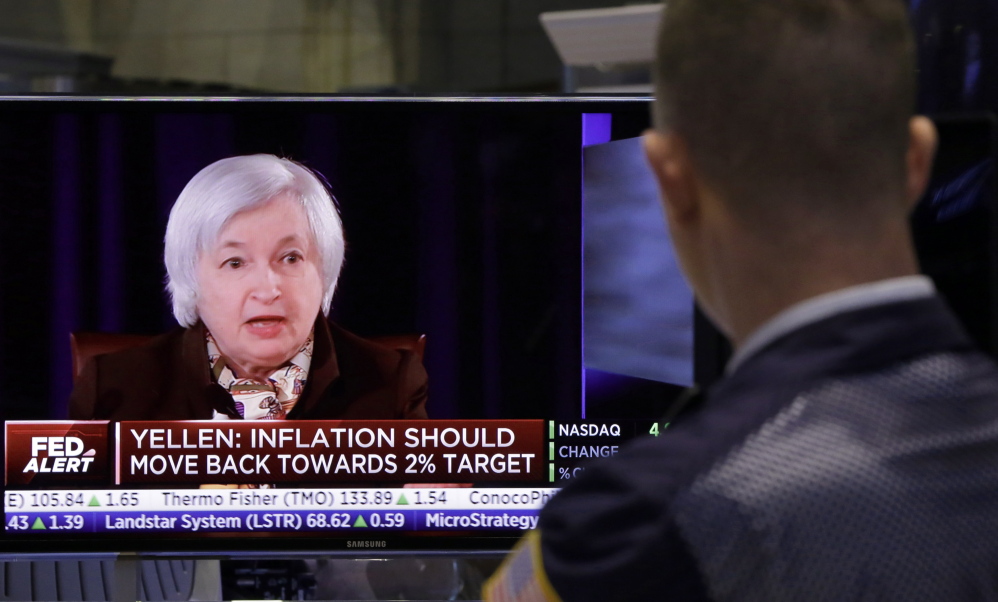WASHINGTON — The Federal Reserve opened the door to an interest-rate increase as soon as June, while also indicating it will go slow once it gets started.
The new signals were contained in a policy statement that ended an era by dropping an assurance that the Fed will be “patient” in raising rates, and in a fresh set of estimates that lowered the median for the federal funds rate the end of 2015 to 0.625 percent compared with 1.125 percent in December.
“Just because we removed the word patient from the statement doesn’t mean we are going to be impatient,” Chairwoman Janet Yellen said in a press conference Wednesday in Washington.
The Federal Open Market Committee said it will be appropriate to tighten “when it has seen further improvement in the labor market and is reasonably confident that inflation will move back to its 2 percent objective over the medium term.”
An increase in the target range for the federal funds rate remains unlikely at the April meeting, it said in its statement.
Yellen is preparing for an exit from the most aggressive easing in the Fed’s 100-year history as the job market overcomes the damage wrought by the deepest recession since the 1930s. At the same time, inflation and wage growth that remain too low are giving her reasons for caution.
While Fed officials lowered their estimate for the federal funds rate at the end of 2015, they said in their statement that “this change in the forward guidance does not indicate that the Committee has decided on the timing of the initial increase in the target range.”
Dropping the pledge to be “patient” marks a shift away from the explicit guidance on the future path of policy that the Fed has used since late 2008 to keep longer-term borrowing costs low. The Fed will now set policy at each meeting based on the latest economic data, making its actions less predictable.
The Fed repeated that it sees “strong job gains” and that labor-market conditions have “improved further.”
Still, the committee lowered its assessment of the economy, saying growth has “moderated somewhat.” In January, it said the economy was “expanding at a solid pace.” Export growth has weakened and the housing recovery remains slow, according to this month’s statement.
Yellen has said the promise to be “patient” means the FOMC would probably wait at least two meetings before raising rates. The next FOMC meetings are scheduled for April and June.
The Fed is preparing to tighten even as stagnant growth elsewhere prompts central banks in Europe, China and Japan to ease policy. That has put upward pressure on the dollar, which has jumped more than 4 percent since Fed policy makers last met on Jan. 28, posing a potential headwind to growth as American exports become more expensive.
Fed officials confront conflicting signals from their dual mandates for full employment and price stability as they weigh when to tighten policy for the first time since June 2006.
Surging job gains pushed unemployment down to 5.5 percent in February, the lowest level in almost seven years, suggesting the economy is strong enough to withstand higher borrowing costs.
Payroll gains have averaged more than 200,000 workers for 12 straight months, the longest streak of such increases since March 1995.
“We are seeing an economy that’s growing above trend,” Yellen said during her press conference. “The labor market is improving” and “some of the headwinds that have held the economy back are receding.”
Send questions/comments to the editors.



Success. Please wait for the page to reload. If the page does not reload within 5 seconds, please refresh the page.
Enter your email and password to access comments.
Hi, to comment on stories you must . This profile is in addition to your subscription and website login.
Already have a commenting profile? .
Invalid username/password.
Please check your email to confirm and complete your registration.
Only subscribers are eligible to post comments. Please subscribe or login first for digital access. Here’s why.
Use the form below to reset your password. When you've submitted your account email, we will send an email with a reset code.